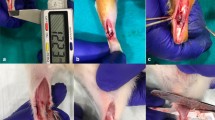Summary
To study wound repair in rat Achilles rendon, we utilized a novel surgical method for immobilizing only one hind limb. In this technique, the femoral vessels were preserved while the skin, muscles, nerves and the shaft for the femur were transected. The limb was then rotated and sutured to lie on the posterolateral flank of the animal. The recovery was prompt and the procedure affected the routine growth and metabolism of the animal minimally throughout the period of experimentation. In the immobilized limb, healing of the Achilles tendon was studied after subtotal severance in the midsection. The rats were killed at intervals of 1, 2, and 4 weeks postoperatively. After 1 week, the surface of the wound was covered by a thin layer of cells. A gap persisted underneath and showed fibrovascular proliferation at the margins. In 2 weeks, the gap was completely occupied by fibrovascular tissue that was beginning to align along the long axis of the tendon. By the 4th week, remodeling had occurred and the site of the wound had almost blended with the rest of the tendon. We conclude that this new technique of hind limb immobilization causes little stress on the animal, and it can be useful for the study of tendon healing.
Similar content being viewed by others
References
Binkley JM, Peat M (1986) The effects of immobilization of the ultrastructure and mechanical properties of the medial collateral ligament of rats. Clin Orthop 203:301–308
Booth FW, Kelson JR (1973) Production of rat muscle atrophy by cast fixation. J Appl Physiol 34:404–406
Chow SP, Yu OD (1984) An experimental study on incompletely cut chicken tendons — a comparison of two methods of management. J Hand Surg [Br] 9:121–125
Date T (1986) The influence of exercise in the healing of rabbit Achilles tendons. J Jpn Orthop Assoc 60:449–454
Drzewiecki AE, Randolph MA, Weiland AJ (1988) Vascularized growth plate transplantation: a comparative study in the rat. Proceedings of the 33rd Annual Meeting of the Plastic Surgery Research Council
Drzewiecki AE, Randolph MA, Weiland AJ (1989) Vascularized growth plate transplantation: a comparative study in the rat. Transactions of the 35th Annual Meeting of the Orthopaedic Research Society
Farmer AW, Farkas LG, Herbert MA (1983) Healing of a split flexor tendon graft — an experimental study in chickens. Ann Plast Surg 10:284–289
Garner WL, McDonald JA, Koo M, Kuhn C, Weeks PM (1989) Identification of the collagen-producing cells in healing flexor tendons. Plast Reconstr Surg 83:875–879
Gelberman RH, Manske PR, Vande Berg JS, Lesker PA, Akeson WH (1984) Flexor tendon repair in vitro: a comparative histologic study of the rabbit, chicken, dog and monkey. J Orthop Res 2:39–48
Kain CC, Russell JE, Rouse AM, Manske PR (1988) Regional differences in matrix formation in the healing flexor tendon. Clin Orthop 229:308–312
Klein LM, Dawson H, Heiple KG (1977) Turnover of collagen in the adult rat after denervation. J Bone Joint Surg [Am] 59:1065–1067
Owoeye I, Spielholz NI, Fetto J, Nelson AJ (1987) Low-intensity pulsed galvanic current and the healing of tenotomized rat Achilles tendons: preliminary report using load-to-breaking measurement. Arch Phys Med Rehabil 68:415–418
Peacock EE (1964) Fundamental aspects of wound healing relating to the restoration of gliding function after tendon repair. Surg Gynecol Obstet 119:241–250
Peacock EE (1965) Biologic principles in the healing of long tendons. Surg Clin North Am 5:461–476
Savolainen J, Myllyla V, Myllyla R, Vihko V, Vaananen K, Takala TES (1988) Effects of denervation and immobilization on collagen synthesis in rat skeletal muscle and tendon. Am J Physiol 254:R897-R902
Author information
Authors and Affiliations
Rights and permissions
About this article
Cite this article
Drzewieckil, A.E., Sarkar, K., Wu, Y. et al. Usefulness of a new technique for hind limb immobilization in rats for the study of tendon healing. Arch Orthop Trauma Surg 111, 39–42 (1991). https://doi.org/10.1007/BF00390192
Issue Date:
DOI: https://doi.org/10.1007/BF00390192




